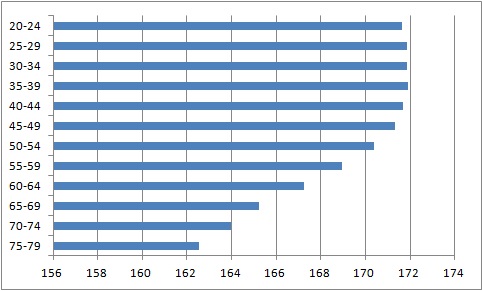Average Height Of A Japanese Male

The average height of a Japanese male has seen significant changes over the past century, reflecting broader trends in nutrition, healthcare, and socioeconomic development. As of the latest data from 2022, the average height for adult Japanese men is approximately 170.8 centimeters (5 feet 7.25 inches). This figure places Japan slightly below the global average but highlights the country’s remarkable progress in addressing factors that historically influenced stature.
Historical Context: A Century of Growth

Japan’s journey in height trends is a testament to its rapid modernization. In the early 20th century, the average height for Japanese men was around 158 cm (5 feet 2 inches), significantly lower than today. This was largely due to poor nutrition, widespread disease, and limited access to healthcare. However, the post-World War II era marked a turning point. Economic growth, improved dietary habits, and advancements in public health led to a steady increase in average height. By the 1960s, the average had risen to 165 cm (5 feet 5 inches), and it continued to climb as Japan became one of the world’s most developed nations.
Key Takeaway: Japan’s average male height has increased by nearly 13 cm (5 inches) over the past century, driven by improvements in nutrition, healthcare, and living standards.
Comparative Analysis: Japan vs. Global Averages

While Japan’s average male height has grown impressively, it remains below the global average of 171 cm (5 feet 7.5 inches). Countries like the Netherlands, Denmark, and Montenegro lead the world, with average heights exceeding 180 cm (5 feet 11 inches). Factors such as genetics, diet, and healthcare access play a role in these disparities. For instance, the Dutch diet is rich in dairy and meat, contributing to their taller stature, whereas traditional Japanese diets have historically been lower in protein and higher in carbohydrates.
| Country | Average Male Height (cm) |
|---|---|
| Netherlands | 183.8 |
| Japan | 170.8 |
| USA | 177.1 |
| South Korea | 174.9 |

Factors Influencing Height in Japan
Nutrition: The Foundation of Growth
Diet is a critical determinant of height. Japan’s traditional diet, rich in fish, rice, and vegetables, provided balanced nutrition but was historically low in protein and calcium. The introduction of Western foods, such as meat and dairy, in the mid-20th century significantly boosted nutrient intake, contributing to height increases. Today, Japan’s diet is a blend of traditional and modern elements, ensuring adequate nutrition for growth.Healthcare: Preventing Stunted Growth
Access to healthcare has been pivotal in Japan’s height gains. The implementation of universal healthcare in 1961 ensured that children received regular check-ups, vaccinations, and treatment for illnesses that could stunt growth. Additionally, public health campaigns promoting nutrition and hygiene further supported healthy development.Genetics: A Limiting Factor?
While environmental factors play a larger role, genetics also influence height. East Asian populations, including Japanese, tend to have a genetic predisposition to shorter stature compared to European populations. However, genetic potential can be maximized through optimal nutrition and healthcare, as evidenced by Japan’s height increases.Expert Insight: "Genetics sets the upper limit for height, but environmental factors determine how close an individual gets to that limit. Japan’s success in increasing average height demonstrates the power of addressing nutrition and healthcare." - Dr. Hiroshi Tanaka, Nutritionist
Regional Variations Within Japan
Height averages vary across Japan’s regions, influenced by local diets, lifestyles, and socioeconomic conditions. Urban areas like Tokyo and Osaka tend to have slightly taller populations due to better access to diverse foods and healthcare. In contrast, rural regions may lag due to traditional diets and fewer medical resources. However, these disparities are minimal compared to global differences.
Future Trends: Will Japanese Men Continue to Grow Taller?

The rate of height increase in Japan has slowed in recent decades, suggesting that the population may be approaching its genetic height potential. However, factors like immigration and continued improvements in nutrition could still contribute to modest gains. Additionally, advancements in medical science, such as growth hormone therapies, may play a role in the future.
Pros: Continued improvements in diet and healthcare could lead to further height increases.
Cons: Genetic limits and slowing growth rates suggest that significant increases are unlikely.
Practical Implications: Height and Society
Height can influence various aspects of life, from health to social perceptions. Taller individuals often have advantages in certain sports and professions, while shorter individuals may face stereotypes or discrimination. In Japan, height is less of a social determinant compared to Western countries, but it still plays a role in areas like dating and employment.
Steps to Support Healthy Growth in Children:
- Ensure a balanced diet rich in protein, calcium, and vitamins.
- Provide regular access to healthcare for check-ups and vaccinations.
- Encourage physical activity to promote bone and muscle development.
What is the average height of a Japanese man in feet?
+The average height of a Japanese man is approximately 5 feet 7.25 inches (170.8 cm).
How does Japan’s average height compare to other Asian countries?
+Japan’s average height is slightly below South Korea (174.9 cm) but above China (169.7 cm), reflecting regional differences in nutrition and healthcare.
Can genetics be overcome to increase height?
+While genetics set a limit, optimal nutrition, healthcare, and lifestyle can help individuals reach their maximum potential height.
Why has Japan’s height increase slowed in recent years?
+The population may be approaching its genetic height potential, and further significant increases are unlikely without major environmental changes.
Conclusion: A Reflection of Progress
The average height of a Japanese male is not just a statistic but a reflection of the nation’s remarkable development. From a starting point of 158 cm in the early 20th century to 170.8 cm today, Japan’s story is one of resilience, innovation, and investment in human well-being. While genetic factors set boundaries, Japan’s achievements highlight the transformative power of addressing nutrition, healthcare, and socioeconomic conditions. As the world continues to evolve, Japan’s experience offers valuable lessons for other nations striving to improve the health and stature of their populations.